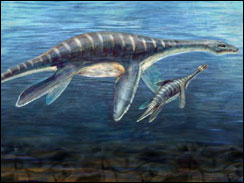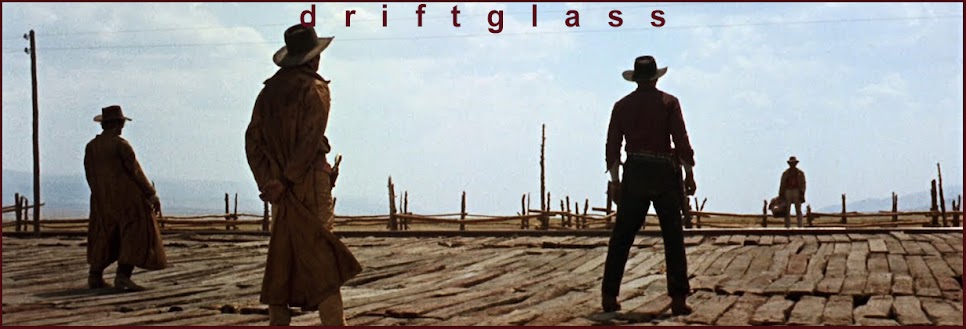
This from CBS News...
Loch Ness Monster Lookalike Found
WASHINGTON, Dec. 11, 2006
(AP) The bones of a baby plesiosaur have been recovered from an Antarctic island, scientists reported Monday.
In life, 70 million years ago, the five-foot-long animal would have resembled Nessie, the long-necked creature reported to inhabit Scotland's Loch Ness.
The new fossil skeleton is one of the most complete of its type ever found, researchers said. It will go on display Wednesday at the South Dakota School of Mines and Technology's Museum of Geology.
Plesiosaurs lived for millions of years in the then-warm southern ocean surrounding Antarctica, with adults growing as large as 32 feet long. With diamond-shaped fins they could "fly" through the water much as penguins do now.
…
The skeleton was found in an area covered with volcanic ash, leading them to speculate that the plesiosaur was killed in an eruption, either by the blast or by ash dumped in the ocean.
Put me in mind of two things. Each beautiful in its own way
First, Alfred “Freddy Baby” Lord Tennyson’s “The Kraken”.
Note the 13th line and the last paragraph of the story.
Below the thunders of the upper deep,
Far, far beneath in the abysmal sea,
His ancient, dreamless, uninvaded sleep
The Kraken sleepeth: faintest sunlights flee
About his shadowy sides; above him swell
Huge sponges of millennial growth and height;
And far away into the sickly light,
From many a wondrous and secret cell
Unnumbered and enormous polypi
Winnow with giant fins the slumbering green.
There hath he lain for ages, and will lie
Battening upon huge sea-worms in his sleep,
Until the latter fire shall heat the deep;
Then once by man and angels to be seen,
In roaring he shall rise and on the surface die.
Second, this snip from the (apocryphal) book of Enoch.
…
And that day
will two monsters be parted,
one monster, a female named Leviathan in order to dwell
in the abyss of the ocean over the fountains of water;
and (the other), a male called Behemoth,
which holds his chest in an invisible desert
whose name is Dundayin,
east of the garden of Eden.- 1 Enoch 60:7-8
Ahhh. Lush writing. Like chocolate-covered-heroin.
Now whatever you do, don’t use this information to mock the Fundies.
Because that would be wrong.
So, so very wrong.


7 comments:
The oceans around Antarctica were warm 70M years ago? Gives you an idea of what an utterly different world it was.
Like chocolate-covered-heroin.
Now THERE'S a seductive image!!
L & L- Antarctica used to be tropical. Wooly Mammoths froze almost instantaneously in Siberia and Alaska. Things went down in ways that scientists have yet to explain. Best of all, it all happened before the Earth was created, but don't tell a Fundie!! ;-)
chocolate covered heroin?
i'm not sure i would cut my chocolate with anything, well, maybe raspberries. . .
still a powerful, disturbing image. brilliant sir.
70M years ago Antarctica was tropical because back then
a) the continent was located somewhat closer to the equator, not smack over the the south pole as it is today, and
b) in ages prior, i.e. during the Cretaceous, Paleocene and especially the Eocene epoch, Earth has been a lot warmer and global temperatures a lot more homogeneous, with temperate climate even in high (polar) latitudes, rain forests extending as far north as 45 degrees latitude, but temperatures at the equator similar to today.
Plate tectonics and continental drift are the reason, not a sudden Hollywood cataclysmic ice age hitting Antarctica. The fossil record of Antartica reveals lush vegetation and teeming life, even after the continent had separated from bigger landmasses and was drifting south into higher (and cooler) latitudes. Some 650M years ago in the Late Precambrium, for example, Antarctica was part of a supercontinent Rodinia and the tectonic plate that was to become Antartica straddled the equator.
The Cenozoic Era, which started ca. 70-65.5M years ago and is still ongoing today, was when the continents moved into their current positions, and is marked by glaciation events interspaced with rapid global warming events (probably due to greenhouse gases esp sudden release of methane from methane hydrid deposits on the ocean floor due to warming of ocean currents) leading to waves of extinction. Between ca. 52 and 36 million years ago, after the Eocene Thermal Maximum that lasted only about 100,000 years, another global cooling period began and ice caps developed in East Antarctica after the Antarctic Circumpolar Current had established itself.
Long-term climate change (in geological scales) is connected to size and distribution of landmasses. Large landmasses all bunched together create socalled "continental climate" with more extremes of heat and cold and aridity, while tectonic activity affects the level of volcanic activity, the erosion/weathering of silicate rocks, and can disrupt or redirect ocean currents like i.e. the Golf Stream responsible for giving the North American east coast and northern Europe a temperate climate.
And last but not least, climate changes feed back into a loop by influencing things like salinity of oceans, melting or build-up of ice caps on mountains and poles, carbon dioxide and methane burial in deep sea sediments, percentage of water vapor in the atmosphere, patterns of precipitation (i.e. monsoon winds), cloud formation and vegetation cover (which itself has an influence on local and macro-climate by regulating humidity and influencing the atmospheric oxygen/carbon dioxide levels directly via photosynthesis or indirectly by provising licing contitions for fungi and animals, especially detritivorous insects like i.e. termites, that break down dead plant matter). Ice caps, vegetation cover and cloud patterns themselves having a direct influence on Earth albedo.
thank you, minstrel boy
MemeHunter said...
Everyone knows that the Aerth was created in 4004 B.C., that the devil buried dino bones to test our faith and that God created all light in the Universe in-transit so that even steallar objection millions of light years away (whose first light which would, by definition, have taken millions of years to reach here)rain their photons us here and now.
So go peddle your anti-Christmas agitprop down the street ;-)
Thanks, us blues.
I like chocolate.
The other, not so much.
I am reminded of Ray Bradbury's short story, "The Fog Horn", describing an ancient dinosaur rising up to the surface, brought by the sound of a lighthouse's fog horn.
Norsecats,
Love that story & haven't thought about it in years.
Thanks
Post a Comment